New chapters are added month by month at the bottom of this page during the year. Gardening Contest begins in August.
Introduction – January/February
Here in Western Ontario, in Zone 6 near the Great Lakes, we have just had a lovely mild spell during the second week of February 2023. A flock of crows arrived on Friday Feb 10th, 2023 and were making a lot of noise as I went shopping. I was so happy to see them and very surprised that birth migration had started as we enter our worst month of winter. I am used to other birds that arrive first. Some have moved on, but a few are still here. Not easy to distinquish between many black coloured birds.

(click on words to open video to listen to its bird sounds)
“Unlike many birds, crows don’t sing loudly to attract mates from a distance. Instead, they sing softly—and at close range—during courtship, with a rich mix of soft cooing, rattles, growls, bowing movements, and mutual nuzzling. A crow’s song is particular to its social group. What are the different sounds of crows? Those are: the classic ‘caw, caw, caw’ means danger; the harsh ‘scold’, the female courting ‘rattle/knock’ call, and the juvenile begging sound. To make up the rest of the over 20 sounds, they use a combo of caws, clicks, coos, grunts and rattles. Crows are very social and stay in large groups for protection. They dislike the sound of wind chimes, and are afraid of hawks. Crows love peanuts at a feeding station.
……………………………..
Another freezing rain last night, mid month, and a snowfall has once again changed the scenery. School buses cancelled and roads slippery and snow covered during the nasty times. Winter has been like this a lot, with mild temps followed by colder ones that brings sleet or freezing rain, followed by dropping temperatures. It has gone as low as -19C but usually more like -8C. Then things warm up again and hover around 0C (32F) for awhile . We had had temps rise to 5C and even up to 10C during this winter. A complete change from the winters that I am familiar with over my lifetime. I do live in a deep snowbelt, and we have had two huge snowfalls. But it has been relatively light at other times. Here is a photo of my balcony with the open feeder covered by snow in one of the big snow blasts.
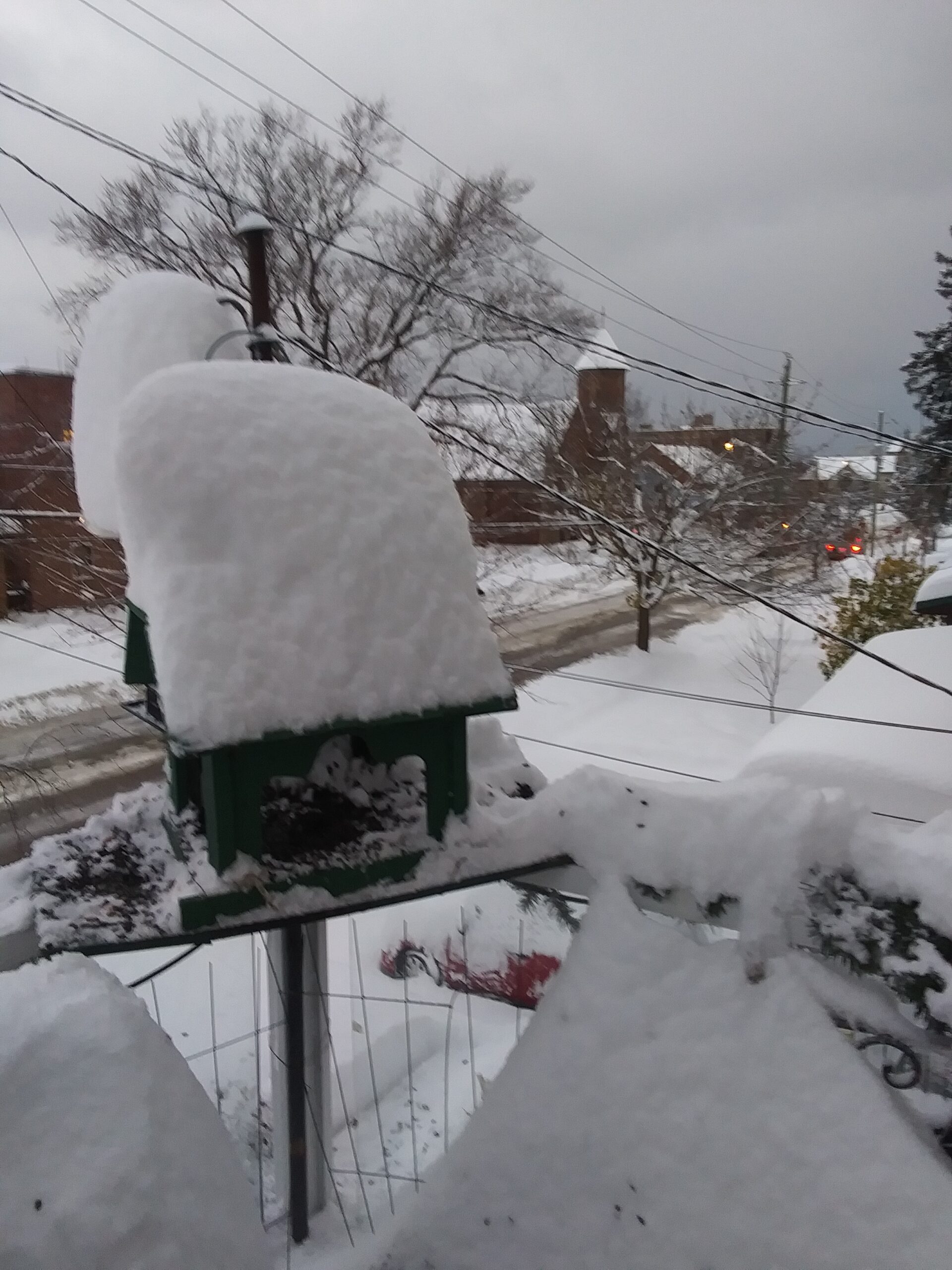
What did concern me in January was seeing a lot of some shrubs and trees with leaf buds swelling. So there may be damage in trees and plants in the ground when spring finally does begin to appear in April. Yes, reports are now coming in (April) of damage to fruit crops in the Niagara region, especially grapes.
I see one of the black squirrels has jumped down off the roof unto my balcony to gobble black sunflower seed in the open feeder. Fortunately the pigeons have been here already several times for morning feed. I usually get about six of them. They are extremely nervous, however, and the slightest thing frightens them away. I raised pigeons as a girl, but mine were not like these.
I had to move my big pole for hanging feeders as the clear dome above them was blocking the TV/Internet satellite reception for neighbours who live below me. The techician discovered that it was the dome that was blocking the signal. He said it had to do with the type of plastic. He covered the satellite dish with a black garbage bag, which did not bother the signal at all.
I moved the main pole to the centre of my balcony (5ft x 10ft), and added a metal squirrel baffle I found at a thrift store. I can happily say the squirrels never bother that setup now. It includes a yellow finch feeder and a bigger metal covered feeder that closes the feed ports under heavier bird weight. It contained a mixed seed. All the birds love that seed mix I bought at a farm store. Niger seed I can pick up in little packets for $2.50 each from a dollar store. Two little bags will fill a simple tube feeder. Big bags are in the $30 range, The Finch and Starlings enjoy Niger Seed. The Starling sits on the balcony railing and just reaches the lower port so are enjoying an occasional nibble.
The squirrels destroyed my best finch feeder with a tray I gave someone, eating holes in it to get at the seed. He was too new at birding to know what would happen if he put a plastic feeder within their reach. They also ate holes in my full size, plastic garbage containers (2) the first year I lived here. I smeared the tops of the cans with all kinds of hot seasonings (cayenne pepper, etc) mixed in petroleum jelly, but that never deterred their efforts to get at bird seed I stored outside in those garbage cans. I dislike squirrels a lot as they are greedy and take more than they need. I never see them carrying off seed to store in their little home. Squirrels are supposed to hibernate during winter, but never do here in the city.
I just bought a new, double, suet feeder ($10) with a roof, and two packets of “Four Season” suet for it. This food contains rendered beef suet, Cut corn, White Millet, Red Milo, Black Oil Sunflower seed. I also changed to a premium mixed seed this month, to mix in with the black sunflower seed in the open platform feeder and the one hanging feeder on the pole. Wow the birds like that combination.
Two clear, 16 inch domes above the two hanging feeders and suet feeder help block the snow and rain while the birds are feeding. Those domes take quite a beating in the winter storms, but are holding up very well. I really like them.
So far I have a few finch and several smaller birds, like Chickadees and Nuthatch. I keep a little bird identification chart here at my desk, but it is not that simple, as most birds seem nervous and don’t stay long. I am two stories up from the ground, and there are lower bird feeders below mine, so I expect they get greater attention. I expect these birds must not have migrated, as I learned many do, a surprise to me since I have always had some in wintertime at my feeders.
Had a pair of Northern Cardinals coming quite often, but not in a while. My recent introduction of a premium seed with smaller seeds in both a hanging feeder and the open one was to entice the little birds back. The pigeons are increasing, as they arrive in a small flock suddenly, eating eagerly on the platform open feeder for a few moments. They are now visiting about three times a day. Oh, here is the female Cardinal back, pausing, snatching a seed and flying away. Now in March they have disappeared for a while.
My neighbour is feeding a bird seed with a lot of corn in it on a table on her front porch, helping delay the squirrels coming to my balcony. I don’t offer very much corn now, as I found it too messy and wasted on the ground in the spring. The table, however, doesn’t cause that, as the squirrels gather there to feed.
Feb 25: A sudden arrival of about 20 Common Starlings on the platform, open covered feeder was a surprise. Have never seen that bird before, although apparently it is quite common. I had to check a bird book to identify it. They left just as suddenly as they arrived. Slowly a few have returned to the platform feeder. 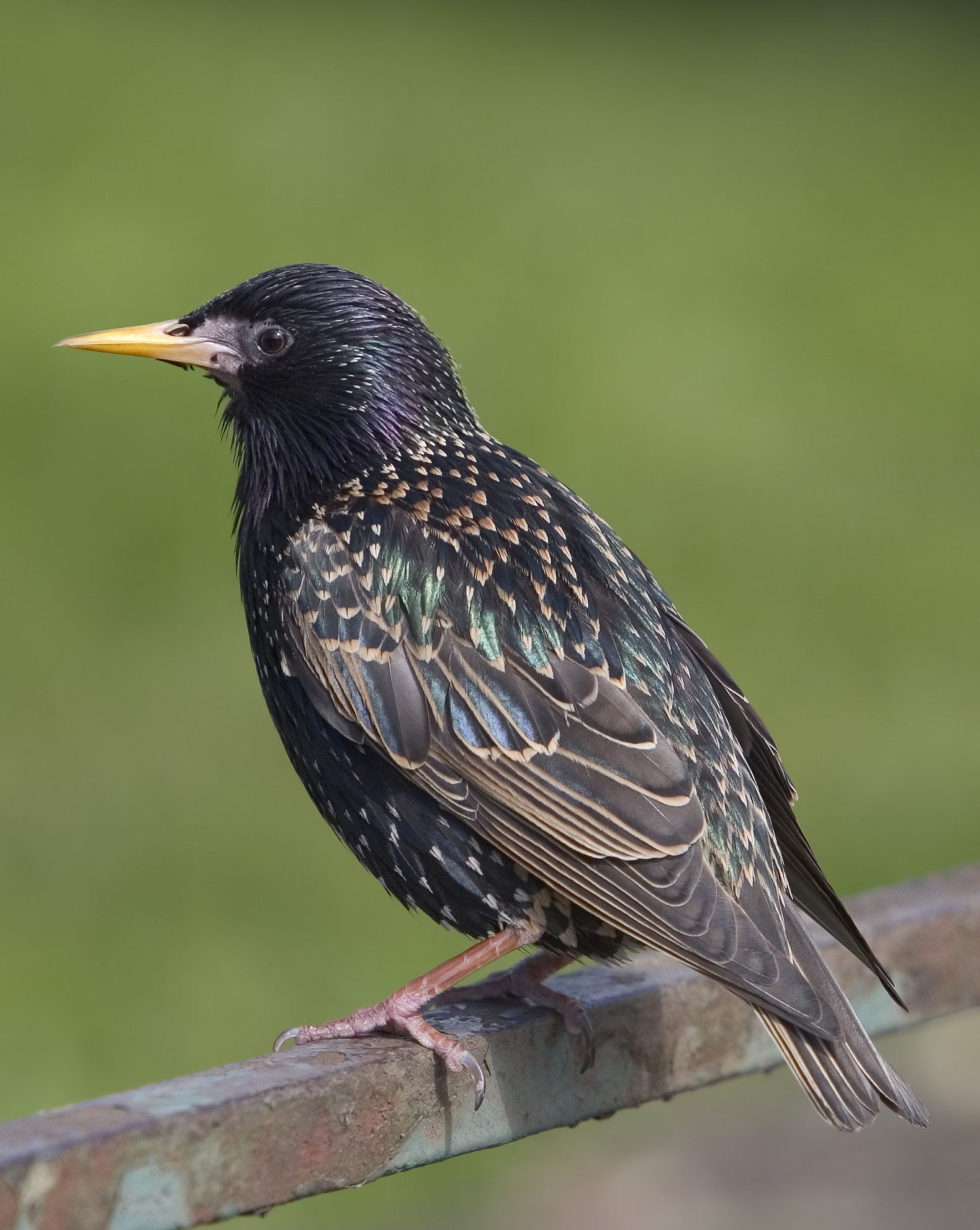
Covered in white spots during winter, Starlings turn dark and glossy in summer. For much of the year, they wheel through the sky and wander across lawns poking their bill into the ground in search of insects. They will eat fruit. as well as grains, nectar, even garbage. Males attract mates by singing near a nest site they’ve claimed and flapping their wings in circles at the same time. The nests are virtually always in a cavity, typically in a building or other structure (look for them in streetlights and traffic signal supports), an old woodpecker hole, or a nest box. Starlings also occasionally nest in burrows and cliffs. Nest holes are typically 10-25 feet off the ground but can be up to 60 feet high. After they’ve paired, males follow their mates everywhere, chasing off other males. Starlings are extremely aggressive birds that drive other species from nest sites they want to use. Starling enjoy suet and a mixed bird seed at my feeders.
…………………………………….
Inside the house, I have found great success growing lettuce from the grocery store. I still have one lettuce seed packet with some other seed packets, all of which I keep in a closed container in the fridge. Keep all seed packets cool until planting, as soon as you buy them. A few need freezing before planting. I plan to start my few seed packets inside in March. I have already decided to grow more flowers this year, and only a few vegetables, like cucumbers and tomatoes. I will buy white and purple Petunias and pink Impatiens plants from a garden centre in a big grocery store, as I do not need very many.
I buy Romaine Lettuce Hearts (3 in a package). When I have ripped off all leaves I want for a salad, I then wet the straight cut that is across the bottom of each plant. I don’t recut it. I just dig a hole in fresh soil in a planter box, pat down the soil around the stub well, and water in a lot, almost every day for the first week or so. It only takes two days and the plant starts sending up leaves.
I also did the celery stalk from the grocery store as well, and it is sending up green leafy shoots. I like a lot of salads, but do not expect these plants to be ready to harvest before spring, meaning two more months. I will I report on that later. First time I have ever raised lettuce this way, and didn’t know you could.
Chapter One – mostly March
Starting Seeds Indoors
Lavender: Feb 19th, 2023. Gathered the equipment I needed. Seed so tiny, so that usually means a light sprinkling on damp soil. Not using Seed Starter this year, because I have a lot of potting soil from last year, 30 minutes in the oven at 350F. Letting the soil cool, and then storing small amounts in a plastic bag I keep with my basic seed starting supplies.
The packet of seeds has been in my fridge since I bought the seed last month, so I am hoping that will break dormancy. If the seed refuses to germinate, I’ll just put the planted Lavender cell packs in the freezer overnight, and start them again.
Opening the package from the bottom– a brand new plastic envelope of seeds (300 mg)– English Lavender from Burbee. (Lavandula angustifolia). I dumped all the seeds into my palm. I then pinched a group of seeds several times and sprinkled them into each cell, until all of the seeds were used up and each cell in a six pack received a nice amount of seed. All gently and lightly pressed down for good contact, but no additional soil added on top. Add a label, and put the cell pack in a tray with a heating pad. If there are signs of drying out in a few days, I with spray with plain water that has been sitting on my kitchen windowsill to kill the chorine in the city tap water. Floride is not affected, but does not seem to harm the seedlings. A little thermometer sits on top of the cell pack to ensure that it does not overhead. No control dial on the heating pad, but I see a comfortable 80F fairly soon, as I want it.
-
- Why are gardening gloves important when handling soil? Because I learned over the years if I don’t, I may get pin worms from handling soil. I assumed that bagged soil would be pasteurized. Nope.
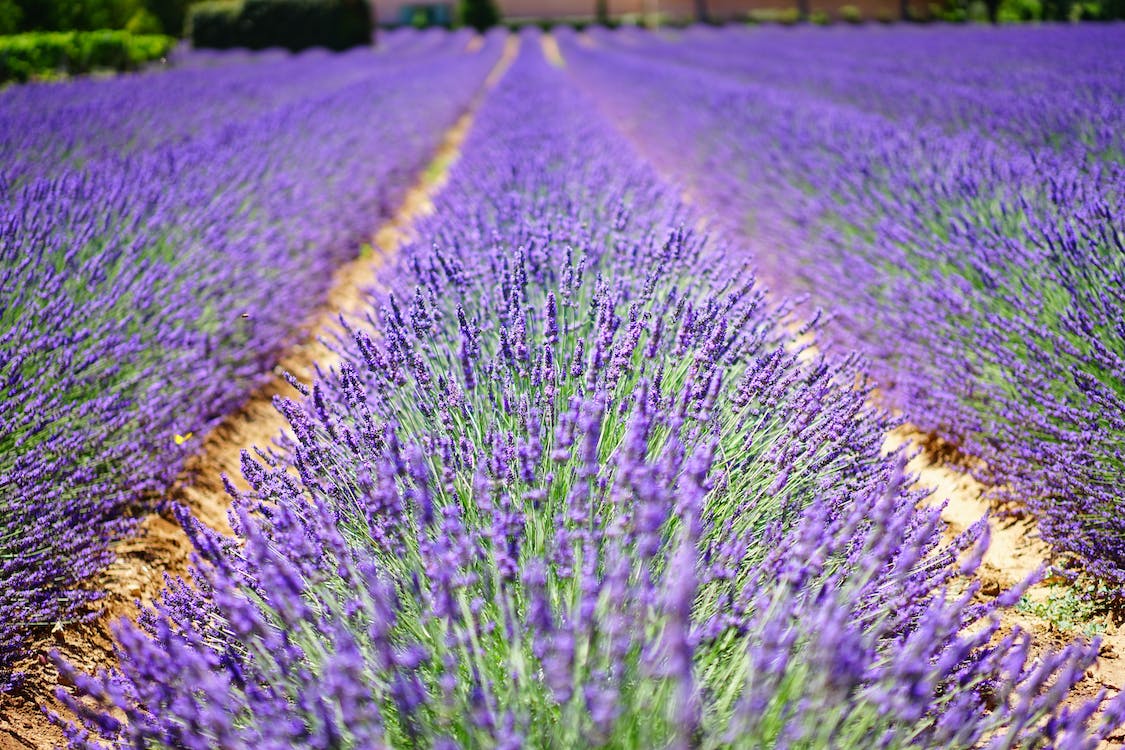
2. How are you going to thin those plants, when so many come up? Don’t plan to do that with lavender. Just want a nice clump from each cell, so I can hopefully have 12 for a perennial edging row of lovely flowers. The gardener in the video I watched says it may take 4 weeks to germinate and that I’ll be lucky to get even one or two seedlings per cell.
3. Is Lavender very hardy?
I have had both success and failure growing this herb in the past. There are different types, and ability to handle winters. For me, this was an impulse buy when I was shopping. I am not planning on growing perennials any more, but it fit my colour palette I want for this year. It takes a long time to get any size on this seedling, so the plant needs starting very early from seeds. Faster start if you use slips from a plant, instead of seeds. Just got in a mood suddenly to get it started, so voila. Lavender makes a beautiful hedge. It prefers dry soil when mature.
I do remember that it easily winter-killed in Zones 5 without a lot of protection. I am just thinking of the name of the hardiest variety of Lavender, but there was only one choice offered when I was in a grocery store. English Lavender/ Hidcote, has done well for me in the past gardens here in Ontario, Canada.
March 1st: The seedlings are up for Lavender. Kept the cell packs lightly damp. With cell packs I usually water them one a week by sitting the packs in a tray of water for a few hours so moisture is drawn upward. The seedlings are too delicate at first for watering from the top, and seeds can be pushed too deep to germinate. Keep little seeds right at the surface because some need light in which to germinate.
I will begin soaking the seeds for Green Peppers overnight, then will plant them in soil in cell packs, water in and then put them on a heating pad for warmth. Soaking seeds speeds germination. Peppers want 80 F degree temps to germinate so I found my little thermometer to put on top of the cell pack to ensures that level. Some gardeners will sterilize their seeds by soaking them in a diluted solution of Hydrogen Peroxide or diluted Bleach. I have never found the need to do this. However, you can add diluted Hydrogen Peroxide in that watering tray, or have a spray bottle with small amount of Peroxide in it. Will help stimulate growth and disinfects the soil.
Knowing when to start seeds may be different in various zones and countries of the world. Here in Ontario, one finds the last frost date and counts back in weeks on a calendar to ensure good growth on seedlings but not to long so they become difficult to manage. There are charts when to plant individual flower and vegetable seeds from many sources, and I keep one on hand to use every spring. Some seeds need special treatment, such as freezing or nicking the outer seed to help it break open. As long as the seed is fresh, and kept cool from fall to spring, it should germinate with little problem. Watch out for stores that use old seed from previous years, having been left in a warm back room all that time. They usually offer a deal to entice buying. Look for a date on the seed packet to get seed produced last summer. I save seed in the fall, so mark mine carefully.
All seedlings need to be hardened off to face outdoor weather, so I use a portable greenhouse for that, beginning in April. May 21st is the common weekend date in Ontario when gardeners are planting seeds and seedlings outside, without danger of frost. How many days to maturity is normally on the outside of the seed package. You can look at that if you want to know when to expect harvest time or flowering for vegetables.
I am only growing a few veggies, and like them well established. Two and a half months before warm crops can go outside to the planter boxes on my balcony in mid to late May. Onions and other cool crops can be planted out there in April, But before that I will have to amend the soil to build up the nitrogen, phosphorus and potash. Crops depleted these nutrients while growing last summer. There are other nutrients as well to consider.
Understanding Soil
The best thing is to test the quality of the soil first to identify the levels of sand, silt and clay content it has, and adjust those to improve water retention or drainage. A simple home method to check this is to get a jar with a lid, add soil samples from several areas of the gardening area. Fill the rest of the clear jar with water. Put lid on, shake or spoon solution thoroughly. Then let contents sit for awhile, which may take a few hours, or overnight.
The solution will settle into distinctive layers that represent the content of each type of particles of the soil: a layer of sand, a layer of silt, and a layer of clay. If one layer is missing, it means that this soil does not have any of that type of material. Since the particles will settle by weight, the layer of sand will be at the bottom, silt in the middle, and clay at the top.
Now sand is usually acidic and clay alkaline, so just looking at those layers will give a glimpse as to the type of soil one has. If the soil has a thick layer of sand, it will be acidic. If lots of clay, the soil will be alkaline. Apparently, one should build up the soil content so that it has 40% sand, 40% silt, and 20% clay content.
One can change the pH a bit, mainly through a light addition of lime to lift acidic soil into a more balanced neutral pH, or the opposite of adding Aluminium Sulphate to lower the pH. Common baking soda will do the same thing.
Now there is a danger of mixing soda (a base), and vinegar, (acidic), which heats up violently, foaming and destroying debis to flush household sink dains. I am not into Cemistry at all, preferring more natural gardening methods than continuing the years and years of chemical abuse of our soils. But I not totally into organic everything at this pôint, with my farming background. It is a learning curve, with much to be explored yet in this whole area of our environment.
Using soil kits for testing of soil content and pH level will give a greater understanding of the current situation with the soil before making amendments to it, if one choses to do that.
Soil Additives
Manure is a natural byproduct of animals. Some people keep rabbits and a few chickens for just this reasons, to improve their gardening soil. I choose sheep manure over cattle manure because in big business, cattle, both dairy and beef cattle may be given hormones and other additives that will appear in their manure. I do not want steroids in my gardening soil, especially when I am growing crops to eat when I add well rotted manure to my gardening soil. I have not studied the latest growing methods for sheep, but many of those sheep products come from other lands, like New Zealand, where pastures are less contaminated than ours are.
Not all cattle are treated this way at all, and lots of farmers are continuingto produce healthy animals and grain products that do not harm us. How to distinquish between them when buying commercial gardening products, let alone our food, is getting harder to distinquish. Everything in gardening begins with the soil.
There are many other additives for soil, like natural fertilizers. Growing green crops, like buckwheat, to turn plough under, will build up the stucture of the soi l, andhelp destroy weeds, before planting an area with a preferred crop. I have planted some patches of buckwheet, and when it begins to flower, turn it over with a round nosed shovel. It naturally wilts and rots. Clovers and Soyabeans are natural nitrogen producers, as are all beans and pêas we grow.
Who knows what all we are growing and eating that is not good for us, without realizing it. The move to organic gardening–no chemical additive–is growing and I am beginning to appreciate it more. But it is not perfect also. I am not yet totally organic in my gardening experiences and with my farming background. There is quite a difference when you are a small family or a single person operation, as oppposed to the conglomerates that are causing this change in my life-time. I like being a simple gardener talking about what interests me at the moment. Each us brings our knowledge and experience to the discussion.
Loams are comprised of a mixture of clay, sand and silt that avoid the extremes of clay or sandy soils and are fertile, well-drained and easily worked.
A pH chart
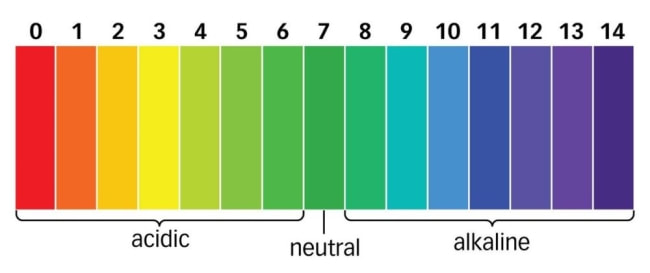
All plants prefer a type of soil in which to grow. Blueberries and Rhododendrons prefer a sandy, acid soil, while most vegetables do better in richly amended, loam soil with a neutral pH of 7.0 . We try to create the soil environment to meet the needs of the plants we plan to grow. Sometimes it is a battle, and far better to find a way to work with the soil we have, instead of contantly trying to change it.
Nutrients in the soil are mainly Nitrogen, Phosphorus and Potash, with some trace elements as well. These nutrients can be tested with a kit, or by studying the general overall growth and leaf colour. More about this a bit later.
I need another shop light, and two grow light tubes, as I didn’t like the modern spread of lights I got last year with its own timer–which went kaput. I lost one of my gardening shop lights when I used it in the ceiling of the chicken pen, that I built at the farm a few years ago.
The stores are loading now with gardening supplies. I picked up a plastic, reusable form for starting the biggest seedlings. Enjoyed chatting with another gardener over that purchase, and others.
Chapter Two – March continued
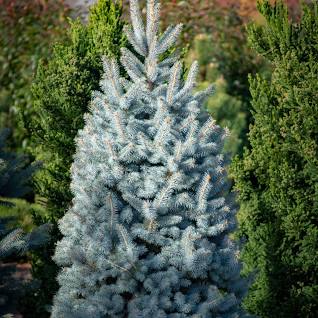
I found a lovely Blue Spruce branch on a roadside in the fall, which had just been dug up and discarded. I brought it home, potted it and it nowabout four feet tall and has new tips appearing.
Lately in early March, I have been putting it outside during the warmer days for the sunshine, but bringing it inside so it won’t freeze. We are experiencing warm days and cold nights, meaning the sap will now start flowing in the trees. My Blue Spruce is still healthy, but the tips are slumping downward, concerning me. I have been watering it thoroughly about once a week, and letting it dry out a bit.
No change seems to have occurred after another week inside. There are needles pointing upward. it is the new tips that are dropping downward. I returned the tree outside near the end of March to face the weather outside, so it can adjust to weather that is warming up. It is in deep soil in a big pot, so I do not expect it to freeze all the way though now. Too rapid a thaw will kill a plant as effecively as too rapid a freeze.
Lots of landscaping businesses have many potted trees and perennials to keep outside during winter. I have noticed they usually cover their pots thickly with a thick mulch, probably to even out the temps during cold winters. It is not freezing, but the fluctuation of freezing and thawing, again and again, that will kill a plant. There are other factors relating to the freezing and thawing of the cells in the plant structure. I am concerned about altitude, as cold intensifies with a rise in height.
By late April, the new growth on my Blue Spruce had died, and I cut them all off to let the stems deal with spring thaw. The tree now looks healthy and doing well, and it seem to have adjusted fine.
Meanwhile, there seems to be a routine pattern now with birds coming to my balcony feeders. It begins around 7:45 to 8:00 am Eastern Daylight Savings has begun. Pigeons arrive for their first morning feed in small groups. Soon afterward come the Starlings who will mingle with the Pigeons. The smaller birds like Finch and Nuthatch and a Woodpecker usually arrive after the dominant birds have left.
No new species has appeared in migration on my platform with the open feeder. However, I do not sit all day watching the arrivals. I just see new birds on my walks. Second feed is around 11:30 am to 1:00 pm, with a final feed between 3:00 and 5:00 pm.
Yes, two neighbourhood black squirrels have their visits, too. Wait….here is another huge flock of extremely hungry starlings in migration who just took over the whole balcony in their desperate need for food. About 30. A pigeon joined them but they quickly return when startled, gobbling everything in site. Gone, just like that in about 10 minutes….I went out and spread seed on the balcony flooring so more can feed at once.
A platform feeder is the best feeder of all…just make sure it has little strips around edging to stop the wind for blowing away the seed there.
I saw some Blackbirds in a tree on my walk yesterday. I am pausing now to listen, trying to identify birds by their vocal calls. Much more sensitive to this than every before. Enjoying these walks a lot as the sun is usually still shining on most days now. Spring is coming.
March 14th. I’ve soaked cucumber seeds in water overnight. Baked some soil from last year in the oven for half an hour to sterilize it a bit, and will find my red cups I like to plant the seeds. I like individual cups better than my large plastic tray I bought simply because I don’t don’t have the room without adding another light fixture. I can move the cups around so easily as the seedling grow, fitting them in here and there. A good bleach wash I will do this morning of the cups, and then get cucumber seeds started. Marketmore, my favourite slicer.
Chapter Three – April
April 7th. Good Friday. All seedlings have been transplanted into deeper red plastic cups, except slow growing lavender. We had a major storm roll through this past week with heavy rainfall. Snow and ice buildup in Ottawa Valley cut off power to a lot of people, including my brother’s house. He has a generator to run power in his home and said it is working fine.
The constant rain has been a good test of all my planting boxes outside to ensure good drainage. One box needed more holes added. Since then, I have added composted manure to each box to mix with the potting soil from last year, to increase fertility before seeding flowers and a few veggies. I did plant Lettuce seed (Black Simpson) in one planter box to take advantage of the dampness. Just sprinkled the seed on top of wet soil. This planter box is against the house wall, and is slightly sheltered and in light shade on my balcony. The seed has now germinated and little plants appearing. Lettuce grows best if slightly sheltered from the bright sunlight. This year I will use three planter boxes for Lettuce growing to ensure continuous leaves for salads. Most food we eat began in someone’ soil.
I have 10 boxes on my 10 ft x 5 ft balcony, 2 urns, and 1 large planter in which I plan to grow Kennebec potatoes and Marketmore cucumbers. Already I have the potatoes in room temperature, hoping they will start to sprout naturally. Not purchased as seed potatoes, but regular ones from the grocery store. Hopîng they do not have an anti-growth spray on them.
I heard quite the commotion yesterday morning that I was able to identify as the arrival of a flock of sea gulls to join the four sea gulls who do not migrate during the winter. Then, in the same evening yesterday (6th) I noticed four turkey vultures circling overhead, possibly the parents and two offspring from last year.
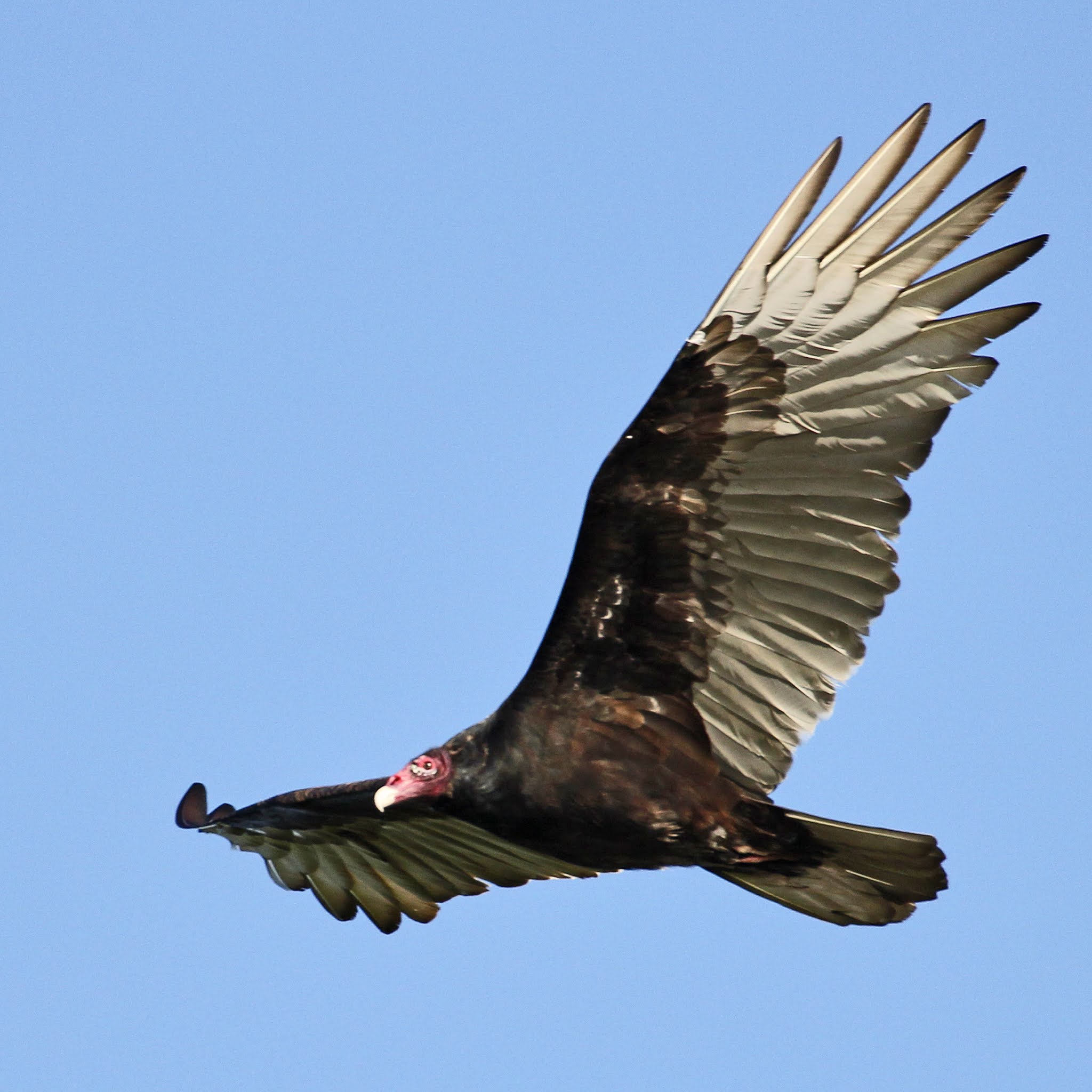
Turkey vultures clean up the countryside of dead animals. They soar far above, spreading their wings in a V shape to soar on the winds. They use their keen sense of smell to find food. Even if the food is tainted with anthrax, tuberculosis or rabies, it will not hurt the bird because of the acid in their stomachs. Their heads are bald. Turkey Vultures prefer to nest in rock crevices, abandoned heron nests, overhangs, ledges, animal burrows or small caves, be they natural or man-made. Pairs are monogamous, have their own nesting territory, and may use the same nesting spot sometimes for decades. Turkey Vultures lack the vocal organs to make proper songs. Most of their vocalizations come down to a form of low, guttural hiss made when they are irritated or vying for a better spot on a carcass. They also may give a low, nasal whine while in flight.
It is time now to start weaning the bigger birds and squirrels from my balcony. I do not want them here all summer, as they may disturb my crops scratching in the planter boxes for spilled seed. Yesterday I watched a hungry black squirrel look across to the pole with all the hanging feeders for smaller birds. Normally squirrels are satisfied from the food they eat in the open feeder. I usually give them 10 minutes each, but often I am too busy to notice. The squirrel tried to get at the yellow finch feeder suspended out from the railing some distance.
I went outside so the animal would leave and brought the feeder inside. I poured out all the finch seed and added 1 tsp of hot cayenne powder to it, mixing it well, and then refilled the feeder. Birds apparently are not bothered by the spice, but its hotness will hopefully teach the squirrels to leave it alone. I also mixed some cayenne powder with Vaseline, and smeared this mixture over the bottom and around the port holes in hopes if he tries to bite and tear at the feeder, he will be discouraged. Hope so. I will have to be on guard though, as I begin to reduce the daily ration for the open feeder. I do not plan to feed big birds all summer long, especially pigeons, which can make a mess with their droppings.
The bird bath is still there beside the open feeder, and so is a deeper pool with a bubbler, as milder temps struggle are developing. A Starling has enjoyed a first bath in that new attachment.
I have just put out a red hummingbird feeder using distilled water. I heated it adding white sugar in ratio of 4 to 1, that is 4 parts water to 1 part sugar. I usually do 2 cups at a time. I prefer to warm the solution almost to a boil to ensure the sugar does blend thoroughly as I stir the liquid. The solution thoroughly cools before I fill the feeder and hang it outside. By the end of April, I had changed it a second time, having completely disinfected the parts of the feeder, so no bacteria develops.
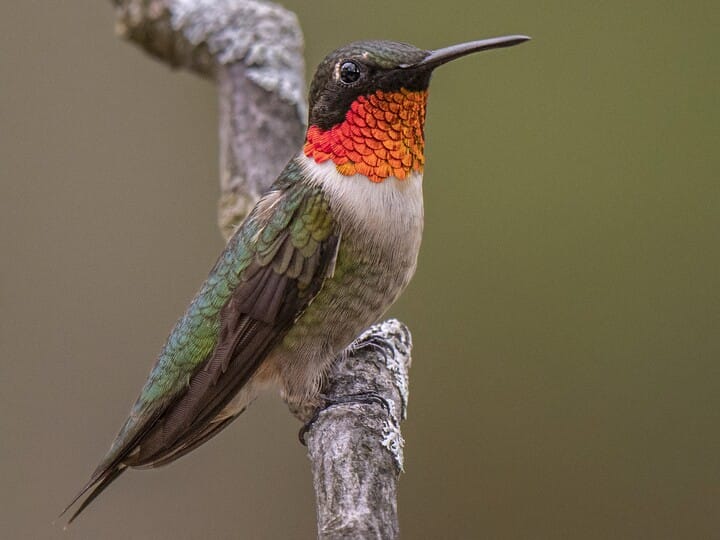
An adult male, ruby throated Hummingbird.
Hummingbirds prefer red and pink flowers, and should arrive any day. I have been following bird reports on the internet as they travel north from their stay far south in Latin America. There are many different colours of Hummingbirds, but we only get this one in Eastern Canada. These little birds can travel a thousand miles without stopping. Once here, they will sit on a branch close to a food source and flit from flower to flower or feeder, frequently feeding every 15 minutes or so all day long.
April has been a difficult month with a lot of rain. The Forsythia yellow-branched shrub is now in full bloom at month end. After the flowering bulbs of white Snowdrops, came Crocus and then blue Scilla in a wonderful sea of blue in many yards. Daffodils are now in full bloom mainly in bright yellow.
Spring is bursting out finally. The branches of shrubs and trees are budding out rapidly, as birds make their nests and little ones begin to hatch. Garden centres are rapidly filling with plants, I bought a couple of blue Pansies for summer blooms. When adjusted to the outdoors, they can handle a lot of cool weather, and bloom for a long period during the summer.
Inside, the Tomato plants and Cucumber Vines had to be staked. I bought some Bamboo ones 36 inches long at the Dollar Store (and cut each one in half, 18 inches long), as supports for growing plants. All plants are doing well, with regular fertilizing spurring them on. Marketmore has started to bloom, meaning I shall have early cucumbers this summer. However, usually this first flush of blooms on Marketmore has only male blossoms. I will be watching for female blossoms, also, in hopes of early cucumbers this year. Pollination is a subject I will leave to a later date, having explained it last year.
I am beginning to think about putting up my portable greenhouse soon outside on the balcony, as growing plants with stakes under florescent light is harder to keep the plants spaced apart, so the cucumber vines do not grab a tomato stake. The Green Peppers are also maturing. I am watching weather reports every day.
The glass surround on the balcony perimeter I do not like as a birder. I set up my metal green fan wires against the glass as inserts in the potting boxes, to alert the birds of the hidden danger. I need a lot more of them. I grew vines on these wires last year. However, it was too late for one little bird that hit the glass in full flight, and died a week ago, upsetting me a lot.
As May approaches, I will study the wind as it moves across my balcony gardening area. Wind can do a lot of damage. Wind is usually the biggest single influence on how a garden grows. We all seek shelter from a strong wind, when we choose where to sit to enjoy our garden. The glass does stop wind abruptly, but up it comes to crash down inside, and injure the delicate plants below. It can even crush them. Watch the wind pick up some leaves and send them spirling all over the place. Wind rebounds off solid surfaces. On my balcony, each glass panel is solid for four feet in length, leaving a one foot open gap. This allows wind to rush through to escape on the opposite side. I am already planning how to filter that wind, as I did last summer.
Wind and Shelter
Should I create a private area with lattice panels, six feet in height x 4 ft wide? Slats that are tight together make a nice wind break. One sees them on top of solid wood fences, for the very purpose I am discussing. However, too expensive and difficult to built at this stage of my older life. It would have to be portable. Still considering what to do this year. The placement of planting boxes is out of that direct wind flow, but I have to restudy it again for placement of the Spruce Tree and small pond. Creating a quiet retreat shelter from wind. A cedar hedge makes a lovely wind break, and gives privacy and creates a natural room divider outside. I added the tallest grasses t to help filter wind in my last outdoor garden.
Here is what I did last year on my city balcony. It was only on the left side of balcony using a garden bench and planting boxes and some fake flowers. The Green Peppers in the photo are in front in another box, giving slight privacy from the road. I spent many mornings in this spot, and it quiets the mind, and brings such enjoyment in a simple environment.
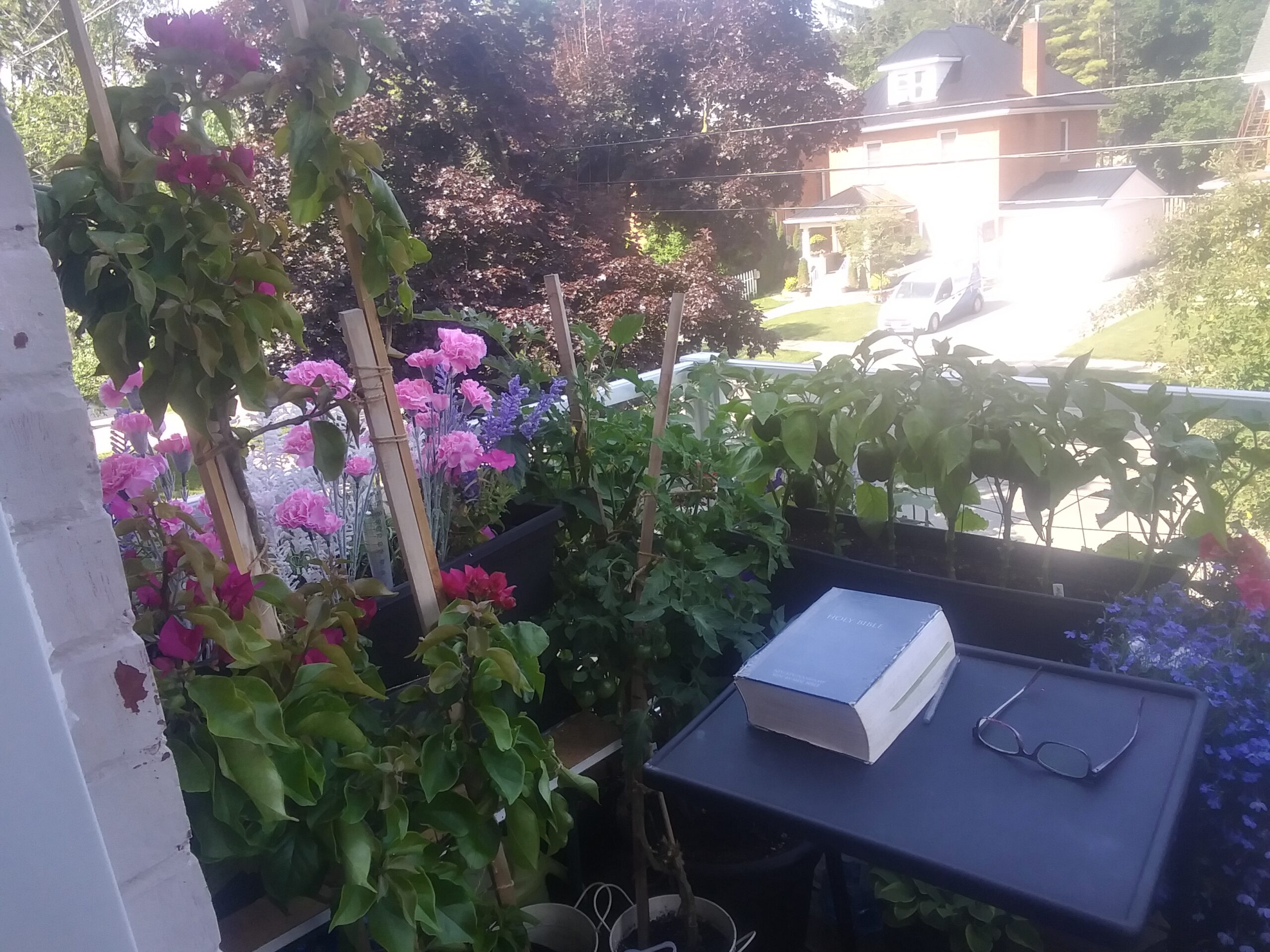
All planter boxes this Spring are covered in clear plastic bags to encourage germination for any seed from the bird feeders that might have dropped into them. The bags also act as a solar heater to kill anything else in the boxes. I haven’t planted anything yet in them, except the one in Lettuce, which is open to all weather conditions, as is the Spruce.
The solar bubbler in that water is working perfectly, so no water loss is occuring. The bubbler stops abruptly in shade, and responds according to the sun’s movement. It circulates the distilled water and helps prevent mosquito and other insect breeding. Just enough height of bubble (not using a spray nozzle), to atract the attention of hummingbirds. The bigger birds have grown accustomed to the water bath at the end of the platform feeder. I change that water every few days. So life continues as Spring arrives.

Chapter Four: May
A cold month with some hot days, as it is near the end, and there are still frost warnings A lovely three-day break I just had to visit Mom’s grave, and to film more tombstones (in Guelph & Coe Hill). It was a lovely celebration of Mother’s Day with my son’s family.
Blackflies were swarming my car up north, but they and mosquitoes did not bother me in the warm sunshine. I was told about a house burning down in the village across from the Public School, but I see a new building going up, taking its place. I spotted several locations in the village with buildings missing. There has been a great effort for village improvements. I commend those who have helped in that work. I could not leave before a stop at Wollaston Lake beach, and then a drive around to see our old fields at the end of Albert Road.
As to birds, mating season has led to nesting sites nearby, especially Starlings in the broken evestrough of the house next door. Robins are plentiful. No Blue Jay has returned. Blackbirds do fly by. Little birds are enjoying my neighbour’s bird feeder below my balcony. The Chickadees continue to stop bymy balcony many times a day for a drink of water at the pool and bird bath. No doubt there are other visitors.
The local newspaper is reporting a sighting of the endangered Piping Plover at a beach, hoping it will linger nearby.

There are many different Plovers. Piping Plovers are sandy grayish brown birds with white underparts and a narrow, often broken collar. They have yellowish orange legs in all seasons. In the breeding season, they have an orange bill with a black tip, a black collar, and a black line on the forehead. In the nonbreeding season, the bill is black and the collar fades to gray and doesn’t go all the way around the breast.
Most of my bird feeders were put away to prevent seed drop and to wean the big birds and squirrels. They dig and scratch in the planting boxes. Gradually I returned the suet cage, and recently changed the hummingbird solution (4 to 1 solution, using Distilled Water). Gardening Season is upon us. Lettuce is coming up nicely, white flowers are blooming on Green Peppers (needing polination by a little brush I keep out there for that purpose), and what a surprise to have a sudden visit by a very fat bumblebee.
Chapter Five: June
A beautiful month for so many flowering shrubs and perennials. I love Bridlewreath Spirea, with is cascading white blossoms all along the stems.
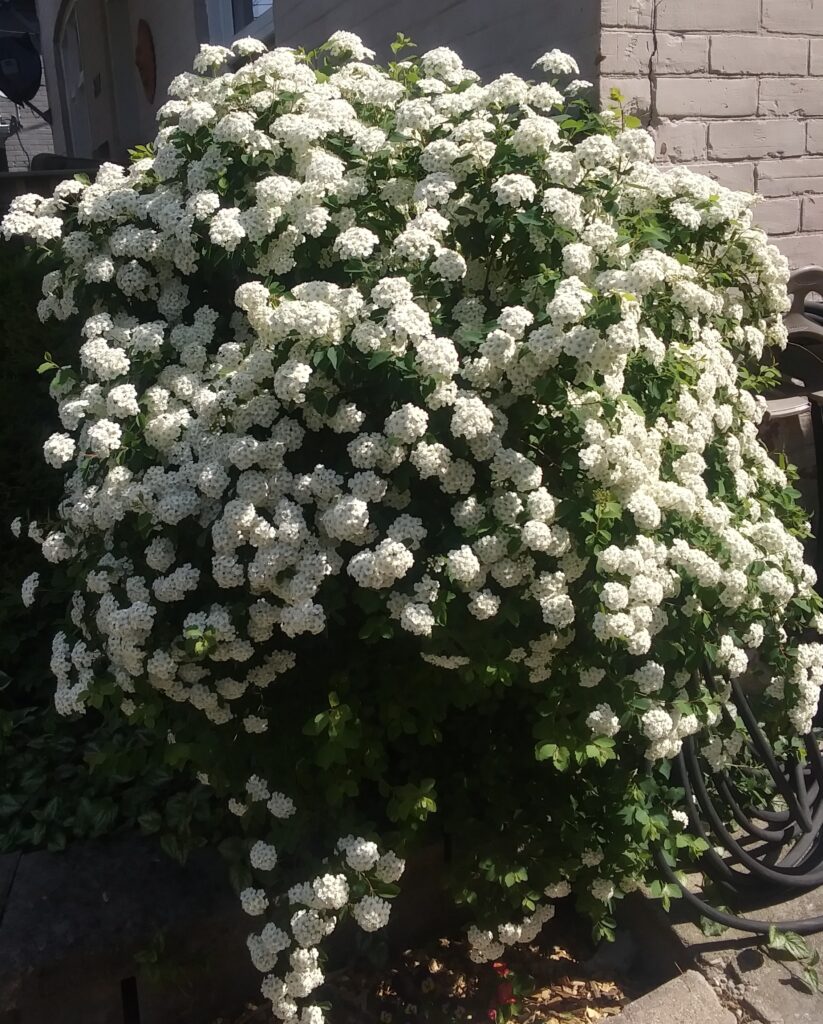
Lots of low growing spireas, and I grown found of the lemon coloured one for its sharp contract. I care less so of other varieties.
This is rose month, and an Alberta Rose shrub is just coming into bloom on my avenue. Wonderful scent, as sadly too many roses are being developed without any perfume. My favourite climber is from the Explorer Series, so hardy in our cold climate. I like John Cabot with its masses of dark pink blooms. Other types of roses like Teas and Floribundas are heavily budded out already. I planted two hardy low growing roses in the Coe Hill Cemetery on Mom and my gravesite, waiting to see if they can settle in without much care and watering. Miniature roses overwintered in Zone 5 without any protection, truly amazing to me. I will check on my roses in the cemetery in late July and ensure they are getting enough moisture this first year.
I tend to think of first year gardening of perennials as the year they sit there and sulk a bit in the soil, then return the next spring to thrive and bloom beautifully during the second year of growth. By a third year, plants now may need thinning or division to rejuvenate and start the cycle all over again. There is a constant cycle of life from birth to maturity to death. Some plants bloom for a few moments or days, never to be seen again. Others needing more time to fulfill their destiny. We are a garden. When physical beauty fades with age, let us enjoy the delights of younger ones around us, while appreciating the lessons that life has taught us. To enjoy each moment, and embrace the destiny awaiting us in death. We, too, shall live again.
Alliums are in full bloom and will soon drop seed, so this plant may spread far and wide in the wind. I gave up on it after a few years for this reason. Iris are also in full bloom the first week of June, along with poppies. Iris get larger each year and need to be divided about every three years. Plant rizones very shallow. One of my all time favourites over a lifetime. The blues and purples add a depth of colour to flower beds.

AUGUST GARDENING CONTEST
I needed help with exercise and went out walking this morning in my neighbourhood. I suddenly realized that some gardens really had a special something that got my attention. So, I have decided to have a Gardening Contest for unsuspecting neighbours. Their not knowing will help us see who really loves this form of art.
Open to anyone, No entry fee. Prizes of $100. $50 and $25.
![]()
